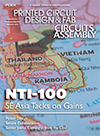Fully Automated Robotic Soldering Automation Celebrates its Tenth Anniversary
In 2008, family-company Eutect GmbH took the first step into robotic automation. Success proved the company right, because time is money for many customers.
Eutect GmbH realizes that every day, because a flexible, efficient, rapid soldering process is on the investment list at many electronics manufacturers. That's why the demand for fully automatic robotic soldering systems is increasing for mini-wave soldering.
"In 2008, we equipped our first machine cell with a kink-arm robot. It was more of a gimmick, because we wanted to know and understand what's possible in the field of component soldering with this technology", recalls Matthias Fehrenbach, managing director of Eutect GmbH. The gimmick has meanwhile become increasingly successful, because the product direction chosen developed into a success story within 10 years. This is especially clear in the IW1 S151 RO. A table system with a 1.5 m x 1.3 m footprint is involved here. The machine is equipped with flux and pre-heat modules as well as mini-waves. A 6-axis robot, which is mounted either on the cell floor or on the cover, transports each assembly within the machine from process step to process step. The IW1 S151 RO can be used as both an in-line and as a stand-alone solution.
"A compact production cell has a smaller footprint, leaving more space for further tasks around the process. However, that also means that we have to act in a manner as flexible and space-saving as possible within the cell's scant space. We can manage this only with a 6-axis robot, which supplies different modules within the machine", Fehrenbach explains. The freely selectable process-module arrangement within the system is decisive here. Through direct agreement with the customers and users, process modules such as flux application, preheating and soldering modules can be positioned so as to minimize transport routes within the machine. At the same time, care must be taken to ensure that all modules are optimally accessible for service and maintenance. Doing so reduces system downtime, and material and space costs as well as personnel expenses. "The efficiency of overall production is therefore automatically increased", summarizes Fehrenbach.
Many opportunities to work within the machine cell result thanks to the 6-arm robot. The associated product grippers, which expand the possibility radius and maximize the use of spaces and processes, complement this flexibility. Up to four different gripper/solder-mask combinations can be stored in a system and tooled fully automatically, which enables a large number of product variants to be processed. "After we understood the opportunities that 6-axis robots offered with the associated grippers, we had to consider a solution for transporting the assemblies before and after the soldering processes", Fehrenbach recalls. Until then, complete workpiece carriers, with all functions and the product to be processed, were often transported through the systems.
However, these workpiece carriers' masses and dimensions aren't optimal for compact 6-axis robots. A 6 kg mass was often exceeded, rendering the workpiece carriers too heavy for compact robotic systems. The company has developed its own workpiece-carrier concept as a result. These workpiece-carrier combinations enable the robot to grab an attachable, product-specific satellite carrier directly from the belt or from an input position and transport it from there to the individual processes. The satellite carrier can also be equipped with various functions such as placement queries, coding, special titanium masks, and many other functions for secure processing, in each case in relation to the product. After process completion, the carrier is dropped onto the conventional workpiece carrier again.
"We always manufacture our satellite carriers in lightweight construction, because doing so enables us to integrate smaller robots with lighter payloads. This allows us to save costs and space for our customers", according to Fehrenbach. The satellite carriers can be easily and quickly converted during a product or variant change. This enables complete workpiece carriers as well as buffer or workpiece-carrier storage to be avoided for each product variant. Additional spare-part storage and further investment costs likewise become obsolete. 'Meanwhile we've been selling a variety of cells with the axis robot integrated head first. Thus for instance, the IW1 S151 or S211 RO can be equipped with powerful preheating and cooling modules as well as brush modules at the end of the process. The overhead-hanging robot provides us with enough space to integrate further modules, with the guarantee that the robot can always access them. Due to this variety of combinations, we can offer our customers unique, individual soldering processes the efficiency and speed of which ultimately provide the former with great benefits", explains Fehrenbach.
For over 20 years, soldering and joining systems have been developed, manufactured, installed, and programmed at EUTECT as well as at customers operating worldwide. The Swabian team of experts offers an extensive, constantly evolving module construction kit for process solutions in the field of soldering.
Process-related and commercially optimal modules for the task description will be selected from the selective soldering- and welding-technology process modules and combined into proven stand-alone, revolving, or in-line production designs for complete solutions.
The EUTECT module construction kit shows that a slim, individual solution comprising proven building blocks for a customer product's task description can often be achieved via individual modules or free combinations.
A technologically comprehensive, innovative EUTECT technical centre is available for optimal solution through evaluation or the manufacture of A-B-C prototypes ready for serial production.
Register now for PCB WEST, the largest trade show for the printed circuit and electronics industry in the Silicon Valley! Coming Sept. 11-13 to the Santa Clara Convention Center.
Press Releases
- SEMI Issues Statement on U.S. H1-B Visa Policy Announcement
- ESCATEC Selects Omnics to Power Next-Generation Supply Chain Planning and Data Intelligence
- Innominds and SIIX launch SIIX-Innominds JV to offer full-stack ODM services in India
- Syrma SGS Technology, Ltd to Accelerate AI-Driven Manufacturing with implementation of analytics and AI solution from Arch Systems in partnership with NMTronics India







